Jazz Review and Conversation: Jane Ira Bloom’s Pandemic Duets
By Steve Elman
“It’s so hard to be a musician and not play . . . There are times you just feel like crying.” – Jane Ira Bloom
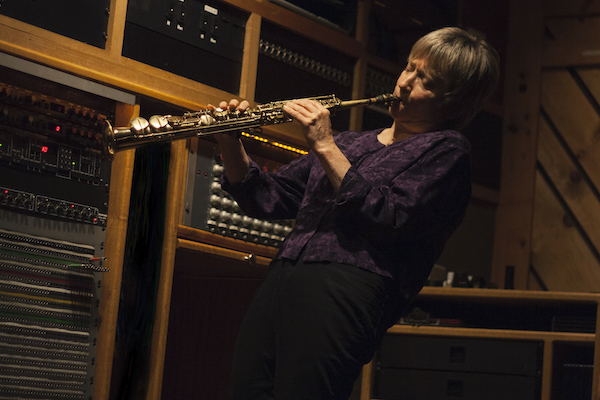
Jane Ira Bloom in action. Photo: Lucy Gram.
Jane Ira Bloom Duets — Some Kind of Tomorrow with Mark Helias and Tues Days with Allison Miller
Jane Ira Bloom hasn’t ever let herself be stymied by circumstances. She responded to her pandemic isolation with two distinctive strokes that have become complements to one another – a CD of duets with bassist Mark Helias released last year, and a CD of duets with drummer Allison Miller that has just been issued. These two duet sessions are unique projects in her discography and beautiful testaments to her ingenuity.
Bloom stands at the midpoint of her 60s, an artist with nothing to prove, but still, after all these years, deserving of wider recognition. No one alive is a greater exponent of the soprano saxophone, and no one, living or dead, has carved out such a wide-ranging body of work on the instrument.
Her history has been a series of challenges overcome.
No major label was interested in her music when she was starting out, in the 1970s. So she did as one of her inspirations, Wadada Leo Smith, advised: she started her own label and learned the record business for herself. When a major label (Columbia / CBS) finally came calling in the late 1970s, she did not choose to play what was selling. She made a deal that allowed her to produce her own records, manage her own budgets, and record just what she wanted to record. When that relationship ended, she balanced the rest of her career between projects with smaller companies (there was a good run with Arabesque, and one-shots with Enja and JMT), and releases on her own label. Like so many others, she found gigging too iffy a way to stabilize her income, so she landed a spot at a progressive institution (the New School in NYC) that satisfies another important desire: to share her ideas and nurture young talent.
But the pandemic presented her with a challenge she had never faced before: it silenced her musical voice.
It is hard for a non-musician to understand the almost physical pain that musicians feel when they are unable to play. The pandemic prompted many creative responses to this pain – outdoor shows in private settings, on-line performances without audience, house concerts, pay-as-you-like subscription services.
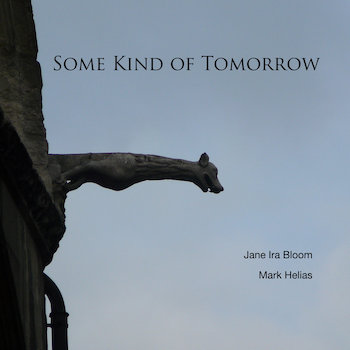 But Bloom is too exacting and meticulous to be so casual about her work. Her art requires thinking and focus – in fact, all of her previous releases have been carefully constructed, often with an overarching idea or at least a sense of theme. Her projects have included an album inspired by the paintings of Jackson Pollock, a suite built on the writings of Emily Dickinson, and a piece for orchestra commissioned by NASA. Her previous duet records have been composed of carefully selected tunes with deeply simpatico partners (We Are, with bassist Kent McLagen, Outline, 1978; As One, with pianist Fred Hersch, JMT, 1995).
But Bloom is too exacting and meticulous to be so casual about her work. Her art requires thinking and focus – in fact, all of her previous releases have been carefully constructed, often with an overarching idea or at least a sense of theme. Her projects have included an album inspired by the paintings of Jackson Pollock, a suite built on the writings of Emily Dickinson, and a piece for orchestra commissioned by NASA. Her previous duet records have been composed of carefully selected tunes with deeply simpatico partners (We Are, with bassist Kent McLagen, Outline, 1978; As One, with pianist Fred Hersch, JMT, 1995).
Faced with a burning need to play and an inability to rehearse effectively with even a small group, she conceived of something new for her – an album of completely spontaneous duets with a long-time partner, bassist Mark Helias.
How to do this when she and Helias could not go to a studio? When I spoke to Bloom in September, she explained how she achieved what she wanted:
“We couldn’t stand the idea of not being able to play, to improvise – it’s what we do . . . We used Zoom for the video . . . [But] Zoom was set up for people to do conferences, not for people to make music. There’s a big delay – [the technical term for it is] “latency” – and you can’t improvise when you’re not getting the information . . . in the moment . . .
“Our friend, [bassist] Mark Dresser, who’s done a lot of work with remote recording, discovered this platform called SonoBus . . . You each set up this software and you can use this program to play with each other, and the latency is very, very subtle. . . .
“We recorded ourselves separately, on another platform. . . We’d do a [simultaneous] clap test [at the start of a recording] . . . when you line up the clap test[s], the two recordings line up.”
Since both Bloom and Helias both have top-quality microphones in their home studios, the result was a recording that rivals any they could make in a professional facility. Helias put the pieces together in his home studio and did the final mix.
They also had the luxury of time they didn’t have to pay for:
“I don’t know how many days we recorded. We’d play for an hour, and then we’d do it on another day, maybe play for two hours. . . . [The music on the CD] is the music that . . . Mark and I [agreed upon] . . . they had something to them.”
Bloom and Helias agreed on the tracks that had that special something, and Bloom released them on Outline, her own label, in 2020, with the title Some Kind of Tomorrow.
A year later, she explains, she decided to do something similar with drummer Allison Miller:
“I had done a concert, a really rough Zoom concert at the New School . . . just me on soprano and her on drums. . . She’s played in my quartet a few times and in my quintet. And then we played this duet concert, and something clicked. . . . So I asked her . . . ‘How about we make these recordings, as I did with Mark, together and separately?’ She has this very sophisticated setup of her drums in her studio in New York . . . We did the same thing, and fortunately, Mark Helias helped us to line up the tracks as our mixing and mastering engineer [again] . . . We did it on five Tuesdays in the spring. March and April of 2021. I think the sessions were about two hours – again, lots of music. It was the same thing [I had with Mark] – we just couldn’t stop. It just felt so good to play. Absolutely no discussion – just play.”
The Miller duets have just appeared, again on Outline, with the title Tues Days.
But: “just play”? Nothing prearranged? No “tunes”?
Yes. Just as with the Helias duets, each came to the recording prepared only to play spontaneously and respond to the other’s ideas.
But because this is Jane Ira Bloom, the music on each of these releases is always remarkably focused and structured, even though the focus is frequently changing and the structure is developing on the fly.
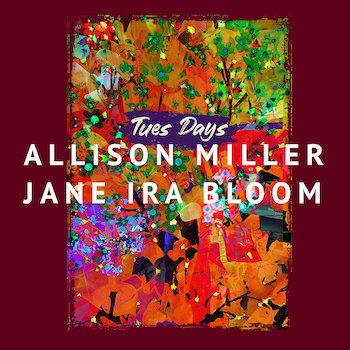 A caveat: it would be a mistake for someone who wants to get to know Jane Ira Bloom’s work to start with either of these recordings. A first-timer should sample her masterpiece of a ballad album Sixteen Sunsets (Outline, 2013). Then, dip into the back catalog and hear one of her most elegant collections of originals (with a few clever adaptations), The Nearness (Arabesque, 1996).
A caveat: it would be a mistake for someone who wants to get to know Jane Ira Bloom’s work to start with either of these recordings. A first-timer should sample her masterpiece of a ballad album Sixteen Sunsets (Outline, 2013). Then, dip into the back catalog and hear one of her most elegant collections of originals (with a few clever adaptations), The Nearness (Arabesque, 1996).
Once you’ve heard what she does with familiar material and original compositions, you’ll be ready to give your ears to these two discs.
Unstructured collective improvisation is nothing new. Lennie Tristano’s groups experimented with it in 1949. Ornette Coleman used it for one of his career landmarks (Free Jazz, Atlantic, 1961). John Coltrane recorded an improvised duet record with drummer Rashied Ali (Interstellar Space, Impulse, 1974 [recorded 1967]). And many musicians of less repute have tried it with different degrees of success. It is now something that almost every living jazz player has done at least once, a skill that must be part of the modern jazz toolkit.
But these Bloom duets are special.
In both cases, because the traditional combination of bass and drums has been split apart, there is no need for any fixed tempos or any fixed harmonic structure.
There also are no “solos” per se. Each player has a few seconds playing without the other, but the flow of ideas back and forth is almost uninterrupted, with one or the other taking the lead at any one time.
Finally, in each case, Bloom is free to be her singing self on her saxophone – and these performances demonstrate once again that she is one of those rare artists who has the Gift of Melody, something that cannot be taught. She says:
“I’m a melodist. I live and breathe – they just come out of me – melodies, whether spontaneously or composed. There’s a lyric and melodic emphasis in my playing that I rejoice in, whether it’s through my own compositions or it’s through the melodic tradition of the American Songbook. That’s there and I hope it always will be there.”
Nonetheless, there is a distinctive character to each disc that reveals itself over multiple listenings. One difference is obvious. Bloom and Helias are playing without a drummer, so they are free to vary tempo, but they must (literally) be in tune with one another harmonically. But when the pairing is saxophone and percussion, both the harmonic and the rhythmic canvasses are blank, so Bloom and Miller are free to go in any direction that seems right.
A more significant difference comes from the character of the two relationships documented here. In a few words, Some Kind of Tomorrow is primarily about spontaneous song and Tues Days is primarily about spontaneous space.
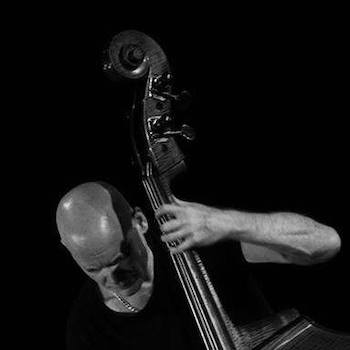
Bassist Mark Helias. Photo: Facebook.
Bloom and Helias are long-time partners, so he is accustomed to being her accompanist, accustomed to a role that is simpatico (which does not mean subordinate). And the combination of bass and saxophone has a particular warmth and sound-color, a steadiness, a continuity. As a result, Some Kind of Tomorrow has the feel of an intimate song recital between old friends. Bloom says:
“Mark and I did talk about this – when you’ve been an improviser for a long time, there’s a certain maturity about the choices that you make, about the choices that you don’t make. And Mark and I can both feel those. There’s a patience you can hear in this music.”
But a drummer-composer has an additional tool at her disposal: the knowledge of how to define a spatial environment with sounds that have no particular tonal value. And that is the primary way in which Tues Days feels different from Some Kind of Tomorrow. Miller gives each track a distinctive aural space; she frames Bloom in a variety of ways and throws shifting colors on the singer at the center. Because Bloom and Miller are both accomplished composers, these duets become adventures in space. Bloom says:
“She’s just filled with ideas. . . . Remember, the soprano is up in that upper register and has a need for timbres that are in the mid- and lower-registers. So I’m sure unconsciously all those things were affecting [Miller’s] decision-making . . . She talked about how this playing stimulated her to grab . . . things she had in her studio that she hadn’t played in years. Something in our music together helped her want to explore all these different sounds – bells, chimes, all kinds of things.”
In a project like this, each listener will have a different favorite track, but let me offer a performance from each disc that stood out for me and may illustrate the qualities I’ve pointed to above:
“Pros and Cons,” from Some Kind of Tomorrow, opens with a few quick exchanges between bass and saxophone, hinting at the blues. Then Helias offers some slow single bass notes, and Bloom floats over them with delicate arpeggios. Helias eases into a very slow tempo without a fixed tonality, with Bloom singing over it, then slurring her notes bluesily. The two hint at a blues framework, but each steps away from it enough to be surprising. Helias has a brief unaccompanied spot, setting up real blues changes, in a slow tempo, and Bloom returns to preach on top of them. Finally, Helias slows things even more, and Bloom signals a conclusion by sweeping her saxophone across the face of her mic.
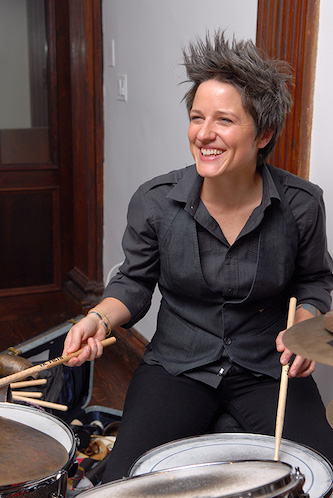
Percussionist Allison Miller. Photo: Artist website
“Light Years Away,” from Tues Days, begins with the only extended passage of solo saxophone on either disc, less than a minute long, in which Bloom seems to me to be recalling lines from one of her most elegant and beautiful tunes, “White Tower.” She elaborates on this as Miller eases in some delicate accompaniment, with mallets on tom-toms and a shaker in one of her hands. Miller gradually adds other effects, settling on a snappy bounce using the rims of her drums, and finally incorporating the entire kit, punctuating with rolling figures that become a continuing effect in the final minutes. Bloom steps away from the lead role and provides some microphone-sweeps as accompaniment for a brief feature for Miller. In the final seconds, Miller continues skating over her whole kit as Bloom gradually re-introduces the harmonies of the first moments and sounds a definitive cadence note to announce the end.
A final recommendation: listen to each track of these releases separately, with a bit of contemplation time between them to savor what you’ve just heard. You’ll hear communication, interdependence, creation that is genuinely cooperative.
This music may provide just what you need to center yourself in this time of trouble.
More:
Bloom’s duet session with Mark Helias (Some Kind of Tomorrow) is hearable on Spotify and available through Bandcamp.
Her duet session with Allison Miller (Tues Days) is also available through Bandcamp.
Of Bloom’s releases discussed above, these are all hearable via Spotify, along with many others:
Mighty Lights (with Fred Hersch, Charlie Haden, and Ed Blackwell; Enja, 1983)
The Nearness (with Kenny Wheeler, Julian Priester, Fred Hersch, Rufus Reid, and Bobby Previte; Arabesque, 1996)
Chasing Paint: Jane Ira Bloom Meets Jackson Pollock (with Fred Hersch, Mark Dresser, and Bobby Previte; Outline, 2013)
Sixteen Sunsets (with Domenic Fallacaro, Cameron Brown, and Matt Wilson; Outline, 2013)
Wild Lines: Improvising Emily Dickinson (with Deborah Rush, Dawn Clement, Mark Helias, and Bobby Previte; Outline, 2018)
As One, with Fred Hersch (JMT, 1995) is not available in its entirely on line but one track is hearable on YouTube.
We Are, with Kent McLagen (Outline, 1978), Bloom’s first recording as a leader, has never been reissued on CD and is not hearable on line.
Lennie Tristano’s 1949 free improvisation experiments, called “Intuition” and “Digression,” were reissued as part of a Tristano – Warne Marsh release (Intuition, Blue Note, 1996) and are hearable on Spotify as part of that album.
Ornette Coleman’s Free Jazz (with Don Cherry, Freddie Hubbard, Eric Dolphy, Charlie Haden, Scott LaFaro, Billy Higgins and Ed Blackwell; Atlantic, 1961) and the John Coltrane – Rashied Ali duets, called Interstellar Space (Impulse, 1974) are also hearable on Spotify.
Jane Ira Bloom has been remarkably articulate about her art, and she had much more to say in my conversation with her in September. I have provided an edited transcript of that conversation in a companion post.
For those who would like to learn more about Bloom’s life and hear more of her work, I recommend:
- an interview conducted by Terry Gross in January 1984 on WHYY, Philadelphia, before “Fresh Air” became a nationally-syndicated program.
- an interview and duo performances from winter 1993 with pianist Marian McPartland, on NPR’s “Piano Jazz”:
- a video conversation with saxophonist-pianist-historian Monk Rowe at Hamilton College in March 1998
- a transcribed interview with Frank J. Oteri (NewMusicBox, September 2018
- a transcribed interview with Gena Raps (persimmontree, Summer 2021).
Bloom herself also recommends an interview by Miyoshi Smith in Cadence, as “one of the most honest and thorough interviews I ever had about what’s going on with the live electronics that I was using.” One source says this interview was published in 1989. Regrettably, I have not been able to locate easy on-line access to it, and Cadence has not responded to a request for it.
Steve Elman’s more than four decades in New England public radio have included ten years as a jazz host in the 1970s, five years as a classical host on WBUR in the 1980s, a short stint as senior producer of an arts magazine, 13 years as assistant general manager of WBUR, and fill-in classical host on 99.5 WCRB.
Tagged: Allison Miller, Jane Ira Bloom, Mark Helias, Some Kind of Tomorrow, Steve Elman

Thanks for the excellent article. I’ll definitely check these out. I’m a great fan of Bloom.
Here’s a recent Arts Fuse review of another Grand Master of the soprano, Dave Liebman:
https://artsfuse.org/238459/jazz-album-review-saxophonist-dave-liebman-still-chasin-the-trane/
Man, I’d love to hear these two in a duet…
Brilliant analysis from Mr. Elman, as usual: thorough, appreciative, sympathetic. Bravos to Jane, Allison, and Mark for pursuing their art creatively during the pandemic vacuum.